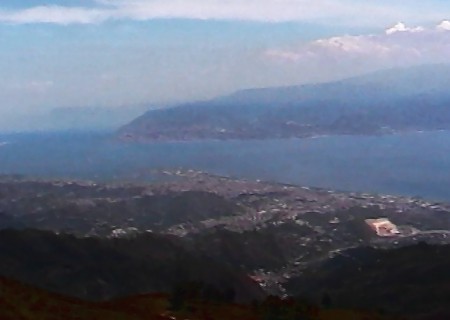| This article is incomplete. This article is missing one or more sections. You can help the BirdForum Opus by expanding it. |
Overview
Although the majority of European raptors choose to cross the Mediterranean at the narrowest points, ie Gibraltar and the Bosphorus, significant numbers move south through Italy, across to Sicily and from there to Cap Bon in Tunisia.
This is an extremely hazardous route and thousands are shot annually but one of the best areas to observe this passage is the Straits of Messina between the Italian mainland and northern Sicily.
Birds
Notable Species
Around thirty thousand raptors of 25 species cross this 3-4km channel with the most numerous being European Honey Buzzard, Black Kite and Marsh Harrier and Montagu's Harrier. Also seen in good numbers are Northern Hobby, Lesser Kestrel and Red-footed Falcon and rare but regular are Egyptian Vulture, Short-toed Eagle, Lesser Spotted Eagle and Booted Eagle.
Both storks also cross the strait as do European Bee-eater and Golden Oriole, Turtle Dove and various passerines including Collared Flycatcher.
At sea both Scopoli's Shearwater and Yelkouan Shearwater are regular spring migrants.
From the Sicilian side of the straits the best place to watch for migrants is the Monte Peloritani, the wooded and scrub-covered hills above Messina.
The Via Palermo leads from Messina to the Peloritani and the crossroads at Portello Castanea after about 5km is a good spot when winds are northerly, a further walk leads to Monte Ciccia which overlooks the straits. When winds are from the south the village of Castanea and especially Santa Rosalia can be more productive.
Highlights have been sometime also Demoiselle Crane, Levantine Sparrowhawk, Eurasian Black Vulture.
Rarities
Rarities such as Black-winged Kite and Levant Sparrowhawk are recorded and Amur Falcon, recorded nowhere else in Europe, has been seen on more than one occasion. In all more than 310 species have been recorded at this site.
Check-list
Birds you can see here include:
Scopoli's Shearwater, Yelkouan Shearwater, Black Stork, White Stork, European Honey Buzzard, Black Kite, Red Kite, Short-toed Eagle, Egyptian Vulture, Western Marsh Harrier, Hen Harrier, Pallid Harrier, Montagu's Harrier, Eurasian Sparrowhawk, Common Buzzard, Long-legged Buzzard, Lesser Spotted Eagle, Golden Eagle, Bonelli's Eagle, Booted Eagle, Lesser Kestrel, Common Kestrel, Red-footed Falcon, Northern Hobby, Eleonora's Falcon, Rock Partridge, Pallid Swift, Eurasian Hoopoe, European Bee-eater, Great Spotted Woodpecker, Blue Rock Thrush, Dartford Warbler, Collared Flycatcher, Eurasian Golden Oriole, Red-billed Chough
Other Wildlife
To do
Site Information
History and Use
To do
Areas of Interest
The Monte Peloritani also has breeding species such as Rock Partridge, Pallid Swift, Blue Rock Thrush and Red-billed Chough with Dartford Warbler in scrub and Great Spotted Woodpecker in wooded areas.
Access and Facilities
Regular ferries run from Reggio Calabria on the mainland to Messina. Spring is undoubtedly the best time to visit with larger numbers in April but the greater variety in May.
There is a camp running every year on both side of the strait hosting visitor birders.
Contact Details
To do
References
A birdwatcher's guide to Italy (Lynx Ed.) 2005.
External Links
Content and images originally posted by Steve
Reviews
ruggiel's review
Pros
- thousands of raptors passing nearby (on your head with unsuitable wind)




